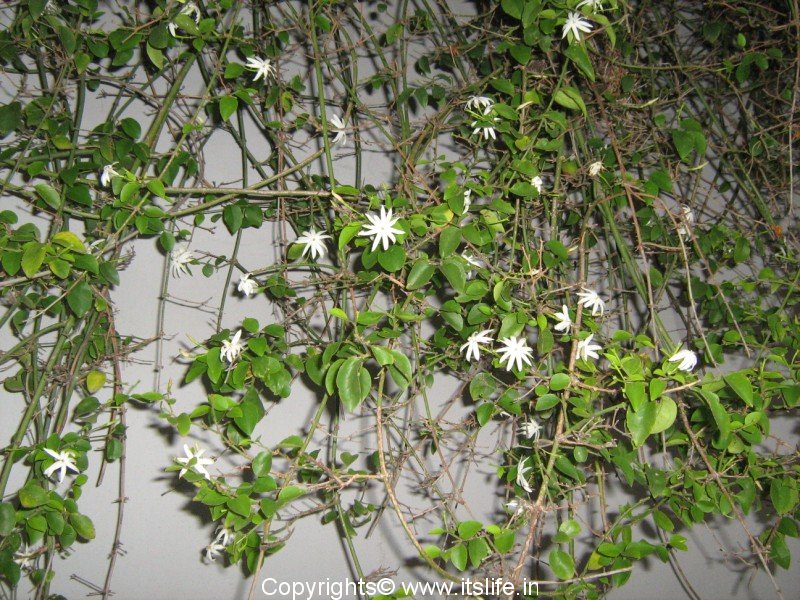Welcome to your holistic living

Botanical Name: Jasminum sambac
Family: Oleaceae
English Name: Jasmine
Malayalam Name: Malli
Hindi Name: Mallika
A woody twining shrub with opposite leaves and fragrant white flower,Leaves -simple ,ovate elliptic ,shiny green.Flowers -white ,highly fragrant,tubular with 5 - 8 lobs bloom mostly at night or early morning.Fruit - small black berry (Rarely seen in cultivated plants ) Flowering season - Through out the year ,more during summer and monsoon Jasminum sambac is an evergreen vine or shrub reaching up to 0.5 to 3 m (1.6 to 9.8 ft) tall.[9] The species is highly variable, possibly a result of spontaneous mutation, natural hybridization, and autopolyploidy. Cultivated Jasminum sambac generally do not bear seeds and the plant is reproduced solely by cuttings, layering, marcotting, and other methods of asexual propagation. The leaves are ovate, 4 to 12.5 cm (1.6 to 4.9 in) long and 2 to 7.5 cm (0.79 to 2.95 in) wide. The phyllotaxy is opposite or in whorls of three, simple (not pinnate, like most other jasmines). They are smooth (glabrous) except for a few hairs at the venation on the base of the leaf. The flowers bloom all throughout the year and are produced in clusters of 3 to 12 together at the ends of branches. They are strongly scented, with a white corolla 2 to 3 cm (0.79 to 1.18 in) in diameter with 5 to 9 lobes. The flowers open at night (usually around 6 to 8 in the evening), and close in the morning, a span of 12 to 20 hours. The fruit is a purple to black berry 1 cm (0.39 in) in diameter. Arabian jasmine in soft shade Jasminum sambac is classified under the genus Jasminum under the tribe Jasmineae. It belongs to the olive family Oleaceae. Jasminum sambac has acquired its English common name, "Arabian jasmine," from being widely cultivated in the Arabian Peninsula. Early Chinese records of the plant points to it being originated in Southeast Asia. Jasminum sambac (and nine other species of the genus) were spread into Arabia and Persia by man, where they were cultivated in gardens. From there, they were introduced to Europe where they were grown as ornamentals and were known under the common name "sambac" in the 18th century. The Medieval Arabic term "zanbaq" denoted jasmine flower-oil from the flowers of any species of jasmine. This word entered late medieval Latin as "sambacus" and "zambacca" with the same meaning as the Arabic, and then in post-medieval Latin plant taxonomy the word was adopted as a label for the J. sambac species. The J. sambac species is a good source for jasmine flower-oil in terms of the quality of the fragrance and it continues to be cultivated for this purpose for the perfume industry today. The Jasminum officinale species is also cultivated for the same purpose, and probably to a greater extent. In 1753, Carl Linnaeus first described the plant as Nyctanthes sambac in the first edition of his famous book Systema Naturae. In 1789, William Aiton reclassified the plant to the genus Jasminum. He also coined the common English name of "Arabian jasmine"
Flowers, root, leaves
Respiratory System Expectorant → Clears mucus and eases breathing. Anti-asthmatic → Relieves bronchospasm Digestive System Carminative → Reduces bloating and gas. Anti-ulcer → Protects gastric mucosa. Mild laxative → Supports bowel movements. Immune System Immunomodulatory → Enhances immune defense via lymphocyte and cytokine regulation. Reproductive System Aphrodisiac → Boosts sexual vitality. Uterine tonic → Supports uterine health. Musculoskeletal System Anti-inflammatory → Reduces swelling and joint pain. Analgesic → Relieves pain. General / Multi-systemic Antioxidant → Protects against oxidative stress. Antimicrobial → Inhibits bacteria and fungi. Wound healing → Promotes tissue repair. Antipyretic → Reduces fever. Sedative / Anxiolytic → Calms nervous system and relieves anxiety
1.Anti oxidant 2.Anti depressant 3.Anti inflammatory 4.Anti pyretic
Rasa: Tikta, Kashaya
Guna: Laghu, Ruksha
Virya: Sita
Vipaka: Katu
Dosha Karma: Tridosha hara